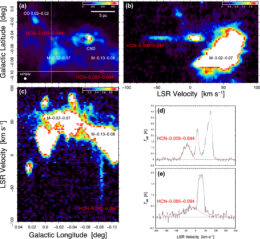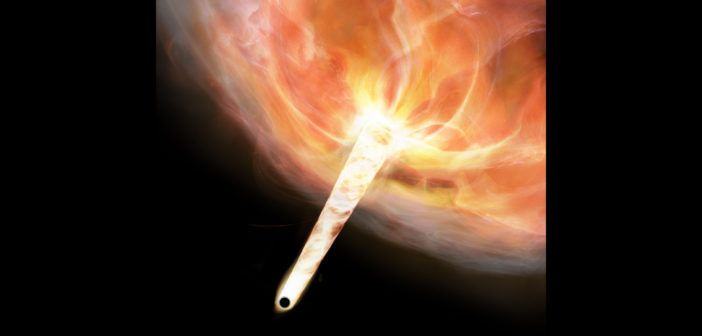Several small, speeding clouds have been discovered at the center of our galaxy. A new study suggests that these unusual objects may reveal the lurking presence of inactive black holes.
Peculiar Clouds

a) Velocity-integrated intensity map showing the location of the two high-velocity compact clouds, HCN–0.009–0.044 and HCN–0.085–0.094, in the context of larger molecular clouds. b) and c) Latitude-velocity and longitude-velocity maps for HCN–0.009–0.044 and HCN–0.085–0.094, respectively. d) and e) spectra for the two compacts clouds, respectively. Click for a closer look. [Takekawa et al. 2017]
Several peculiar gas clouds have been discovered within the Central Molecular Zone within the past two decades. These clouds, dubbed high-velocity compact clouds, are characterized by their compact sizes and extremely broad velocity widths.
What created this mysterious population of energetic clouds? The recent discovery of two new high-velocity compact clouds, reported on in a paper led by Shunya Takekawa (Keio University, Japan), may help us to answer this question.
Two More to the Count
Using the James Clerk Maxwell Telescope in Hawaii, Takekawa and collaborators detected the small clouds near the circumnuclear disk at the centermost part of our galaxy. These two clouds have velocity spreads of -80 to -20 km/s and -80 to 0 km/s and compact sizes of just over 1 light-year. The clouds’ similar appearances and physical properties suggest that they may both have been formed by the same process.
Takekawa and collaborators explore and discard several possible origins for these clouds, such as outflows from massive protostars (no massive, luminous stars have been detected affiliated with these clouds), interaction with supernova remnants (no supernova remnants have been detected toward the clouds), and cloud–cloud collisions (such collisions leave other signs, like cavities in the parent cloud, which are not detected here).

Masses and velocities of black holes that could create the two high-velocity compact clouds fall above the red and blue lines here. [Takekawa et al. 2017]
Revealed on the Plunge
As an alternative explanation, Takekawa and collaborators propose that these two small, speeding clouds were each created when a massive compact object plunged into a nearby molecular cloud. Since we don’t see any luminous stellar counterparts to the high-velocity compact clouds, this suggests that the responsible objects were invisible black holes. As each black hole tore through a molecular cloud, it dragged some of the cloud’s gas along behind it to form the high-velocity compact cloud.
Does this explanation make sense statistically? The authors point out that the number of black holes predicted to silently lurk in the central ~30 light-years of the Milky Way is around 10,000. This makes it entirely plausible that we could have caught sight of two of them as they revealed their presence while plunging through molecular clouds.
If the authors’ interpretation is correct, then high-velocity compact clouds provide an excellent opportunity: we can search for these speeding bodies to potentially discover inactive black holes that would otherwise go undetected.
Citation
Shunya Takekawa et al 2017 ApJL 843 L11. doi:10.3847/2041-8213/aa79ee


7 Comments
Pingback: are fast clouds evidence for speedy BHs?
Pingback: Accademia delle Stelle
Pingback: Nubi a tutta velocità rivelano buchi neri nascosti | Accademia delle Stelle
Pingback: Las nubes de alta velocidad podrían revelar la presencia de agujeros negros invisibles – Observatori Astronòmic
Pingback: Agosto 2017 – Observatori Astronòmic
Pingback: Nubes compactas de alta velocidad en Sgr A « SEDA / LIADA - RedLIADA - Cursos LIADA - Cielo del Mes - Fenómenos Astronómicos - RELEA
Pingback: Nubes del alta velocidad reveladores « Sección de Astrofísica